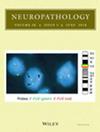Rare dual‐genotype IDH mutant glioma: Review of previously reported cases and two new cases of true “oligoastrocytoma”
IF 1.3
4区 医学
Q4 CLINICAL NEUROLOGY
引用次数: 0
Abstract
In 2016, the World Health Organization (WHO) eliminated “oligoastrocytoma” from the classification of central nervous system (CNS) tumors, in favor of an integrated histologic and molecular diagnosis. Consistent with the 2016 classification, in the 2021 classification, oligodendrogliomas are defined by mutations in isocitrate dehydrogenase (罕见的双基因型IDH突变胶质瘤:回顾先前报告的病例和两例新的真性 "寡细胞瘤 "病例
2016 年,世界卫生组织(WHO)将 "少突胶质细胞瘤 "从中枢神经系统(CNS)肿瘤分类中删除,转而采用组织学和分子诊断相结合的方法。与 2016 年的分类法一致,在 2021 年的分类法中,少突胶质瘤的定义是异柠檬酸脱氢酶(IDH)突变,同时伴有 1p19q 编码缺失,而星形细胞瘤是 IDH 突变肿瘤,通常伴有 ATRX 缺失。2007 年,一名 24 岁的男子出现脑瘤,组织学描述为星形细胞瘤,但分子研究结果与少突胶质细胞瘤一致,IDH 突变且 1p19q 缺失。多年后,在切除手术中,病理结果显示为星形细胞瘤,ATRX表达不稳定,DNA测序显示IDH、ATRX、TP53和TERT突变。荧光原位杂交研究证实,在组织学显示保留ATRX表达的肿瘤切片中,存在1p19q编码缺失。另外,2017 年,一名 36 岁女性出现额叶脑瘤,病理符合少突胶质细胞瘤、IDH 突变和 1p19q 编码缺失。两年后,病理显示为星形细胞瘤,IDH1 突变,ATRX 缺失。这两个病例很可能代表了罕见的双基因型 IDH 突变浸润性胶质瘤。此前有文献报道了9例双基因型IDH突变胶质瘤。我们介绍了两个病例,这两个病例在同一部位的肿瘤中出现了这种不同的分子表型,而且在两个时间点进行了手术,切除时均有1p19q编码缺失和ATRX缺失。这究竟是真正的 "碰撞瘤 "还是随时间发生的基因转换尚不清楚,但这些混合突变的共同出现支持双基因型 IDH 突变胶质瘤的诊断。
本文章由计算机程序翻译,如有差异,请以英文原文为准。
求助全文
约1分钟内获得全文
求助全文
来源期刊

Neuropathology
医学-病理学
CiteScore
4.10
自引率
4.30%
发文量
105
审稿时长
6-12 weeks
期刊介绍:
Neuropathology is an international journal sponsored by the Japanese Society of Neuropathology and publishes peer-reviewed original papers dealing with all aspects of human and experimental neuropathology and related fields of research. The Journal aims to promote the international exchange of results and encourages authors from all countries to submit papers in the following categories: Original Articles, Case Reports, Short Communications, Occasional Reviews, Editorials and Letters to the Editor. All articles are peer-reviewed by at least two researchers expert in the field of the submitted paper.
 求助内容:
求助内容: 应助结果提醒方式:
应助结果提醒方式:


